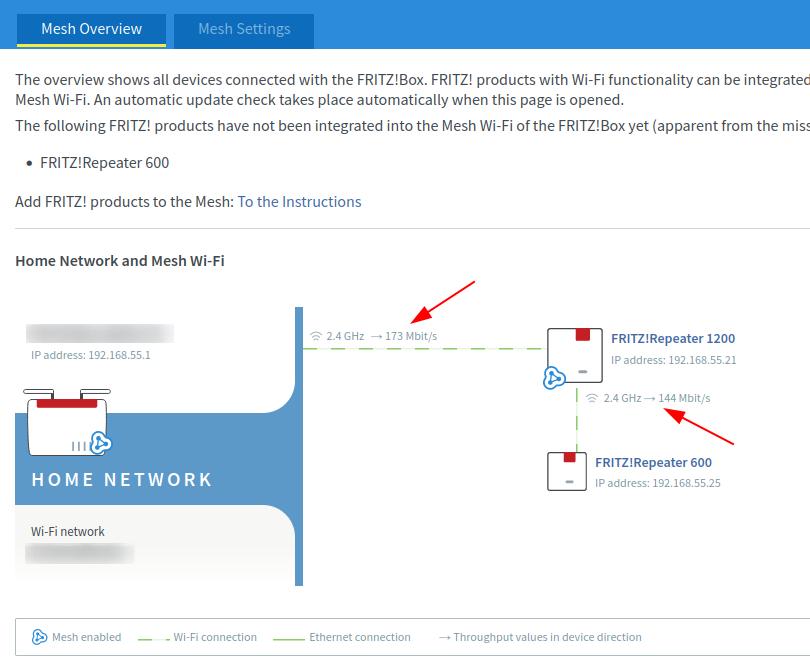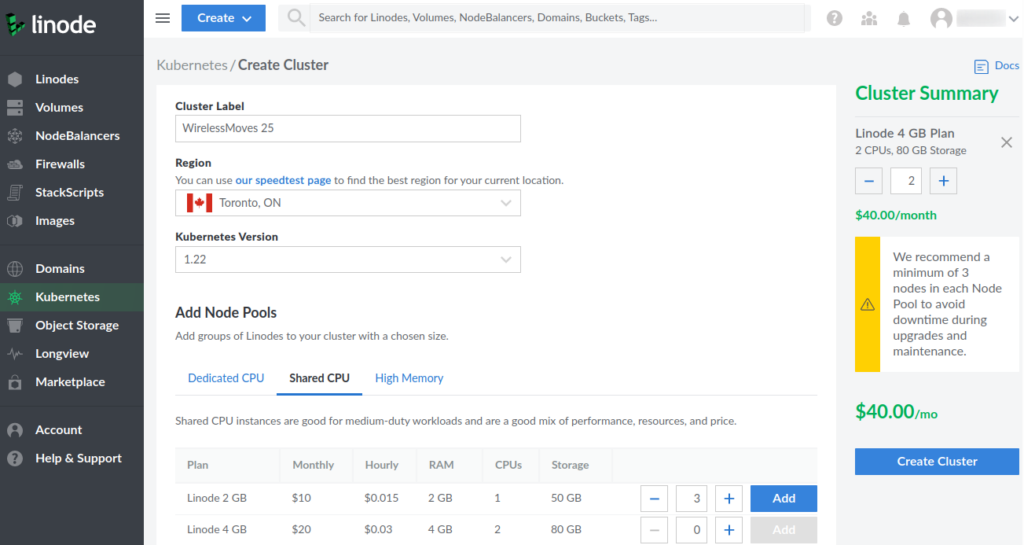In part 8 of this series on Kubernetes, I’ve used ‘Helm’ and ‘Helm Charts’ as an easy way to deploy a complicated Kubernetes Ingress configuration with a few commands. At the time, I left it at that and decided to come back later and explore ‘Helm’ in more detail. So here we go. In this post, I’ll have a look at what Helm is and show how to create a Helm chart for deploying several WordPress Blogs with a MySQL databases into a managed cluster.
Continue reading Kubernetes Intro – Part 11 – Helm Charts RevisitedAuthor: Martin
Daisy Chaining Wi-Fi Repeaters

A few meters can make a difference between 80 Mbit/s and zero reception. Recently, I was asked to see if I could improve the in-house LTE coverage of a small home. On the ground floor, even close to the windows, reception was pretty much zero. On the third floor, where one has a nice overview of the town, however, I could easily get 80 Mbit/s from the external LTE network. So the solution was clear, let’s put an LTE / Wi-Fi router there instead of using LTE directly on mobile devices on the ground floor. The problem: Even though the house is old and not much steel has probably been used to build it, the Wi-Fi signal wouldn’t go well through two floors.
Continue reading Daisy Chaining Wi-Fi RepeatersChasing Bit Rot with MD5 Hashes

When I recently copied a couple of hundred gigabytes from one backup drive to another backup drive, things did not go quite according to plan: After a few hours, the Linux kernel reported read issues on the source drive and remounted the drive in read-only mode. Rsync borked and aborted. I eventually fixed this by using a different cable and by connecting the drive to a USB port directly on my notebook. But this shouldn’t have happened in the first place, so I was wondering a bit how my backup on that drive is really doing. So I decided to have a closer look by verifying the integrity of the data on the drive. The results were interesting.
Continue reading Chasing Bit Rot with MD5 HashesKubernetes Intro – Part 10 – Persistent Storage in a Managed Cluster
Wow, this is part 10 in my series on how to get started with Kubernetes! I am obviously having a lot of fun with the topic, and it’s really nice to be able to experiment with the technology, as it is not only the basis for 5G core networks, but massively transforms all parts of telecommunication networks in general. Today’s topic: How to store data persistently in a managed Kubernetes cluster (with a practical example, of course).
Continue reading Kubernetes Intro – Part 10 – Persistent Storage in a Managed ClusterKubernetes Intro – Part 9 – Deploying Your Own App
And I’m moving along with the exploration of how to use a managed Kubernetes cluster. In the previous episode, I’ve gone into the details of how to deploy applications into a cluster and hook them up to an Ingress load balancer, so they are reachable from the outside. In this episode, I want to expand on Part 3, in which I explored how to develop a simple node.js based app locally and push it into a local Minikube. The challenge: How can I push my locally developed app into a remote managed Kubernetes cluster?
Continue reading Kubernetes Intro – Part 9 – Deploying Your Own AppDecommissioning My 2009 Notebook And A Look Inside

A bit of a history and hardware post today: 12 years ago, back in November 2009, I bought my last notebook I mainly used with Windows for a few years, a Toshiba Satellite L550. At €555 euros, it was a mid-priced notebook and surprisingly, it has lasted me 12 years, and was in use almost daily.
Originally shipped with Windows Vista, I upgraded to Windows 7 at some point in 2010. Some time later, I installed Ubuntu alongside and Windows was pushed to the sidelines. After a few years, I moved on to another notebook for my daily work, but due to its 17″ screen, the L550 remained in use as a video streaming device. For many years, the hardware was capable enough to stream most videos in the browser or watch local videos with VLC. So the only upgrade I made to that notebook in 12 years was switching from a 256 GB disk drive to a 256 GB SSD around 4 or 5 years ago.
But even with the SSD, the point had come after 12 years at which program startup delay compared to other devices in the household became very noticeable and not all videos, especially in the browser, would run smoothly anymore. So I replaced the device with a new HP 17″ notebook with an 11th generation Core i5 processor, i.e. a notebook with 11 hardware generations of enhancements. The price of the new notebook was almost exactly the same, which means, that prices in the mid-range segment have not significantly fallen over the decade. But obviously, many improvements have happened over time, so it’s interesting to compare the hardware of then and now to see what has changed.
Continue reading Decommissioning My 2009 Notebook And A Look InsideKubernetes Intro – Part 8 – Deploying Stuff into a Managed Cluster

In part 5 of this series, I’ve been looking at how companies like Linode, DigitalOcean and Amazon offer managed Kubernetes cluster instances. In other words, they provide Kubernetes clusters in freely configurable sizes, which can then be used for projects. The approach is quite different from how I thought it would work: Effectively, you get your own Kubernetes cluster(s) that work and feel the same way as any private Kubernetes installation, be it a Minikube, which I explored at the beginning of this series, or be it a huge private cluster installation. So how hard can it be to run the same exercises on such a managed remote cluster as on the Minikube?
Continue reading Kubernetes Intro – Part 8 – Deploying Stuff into a Managed ClusterKubernetes Intro – Part 7 – Istio – What Is A Service Mesh?
Once upon I time when I started learning about Kubernetes, I thought it was a one-stop-shop to manage containers that are distributed over many servers. But the more I learn about the topic, the more I realize that while Kubernetes offers a lot of functionality, there are many things it doesn’t do out of the box, and for which 3rd party products are used. In recent weeks, I’ve come across the terms Istio and “Service Mesh” a lot, so it was time to have a closer look at what this actually is and which problems a service mesh solves in a Kubernetes cluster.
Continue reading Kubernetes Intro – Part 7 – Istio – What Is A Service Mesh?Kubernetes Intro – Part 6 – Managing All Those Clusters
Yes, this is already part 6 of my ongoing Kubernetes intro series. In part 5, I have moved ever deeper into the cloud by looking at how to create managed Kubernetes clusters in Amazon’s and Linode’s clouds. Containers and Kubernetes are all about scale, so one might wake up one day with many Kubernetes clusters to manage. And you might have guessed it, that must be automated as well to further scale infrastructure. There are quite some tools available for managing all the Kubernetes clusters of an organization, and today I will have a look at three of them, Cluster API, Flux CD and Argo CD.
Continue reading Kubernetes Intro – Part 6 – Managing All Those ClustersKubernetes Intro – Part 5 – A Cluster on Amazon and Linode

It’s amazing how in the past year or so, efforts in the telecom industry to move next generation systems into containers and manage them with Kubernetes have moved from theory to practice. The 5G core, for example, was specified by 3GPP in a cloud native way from the start, and even things like Open Radio Access Network (Open-RAN), whose specification effort started a bit earlier and hence is still based on Virtual Machine technology is moving quickly to container based solutions in the real world. This was one of the reasons while about a year ago I had another look at Docker and Kubernetes which resulted in my Docker and Kubernetes introduction posts on this blog. Also, I have dockerized a number of services I host for myself (e.g. this blog!) and use containers in my own software development and deployment process. This has made it much easier to spawn independent instances of my document research database for various friends in minutes instead of hours. But as far as Kubernetes is concerned, I don’t really have a practical use case myself, so I did not go beyond a Minikube installation. So one thing that always remained a bit opaque to me is how Amazon and other hyperscalers make Kubernetes clusters available from their data centers.
Continue reading Kubernetes Intro – Part 5 – A Cluster on Amazon and Linode